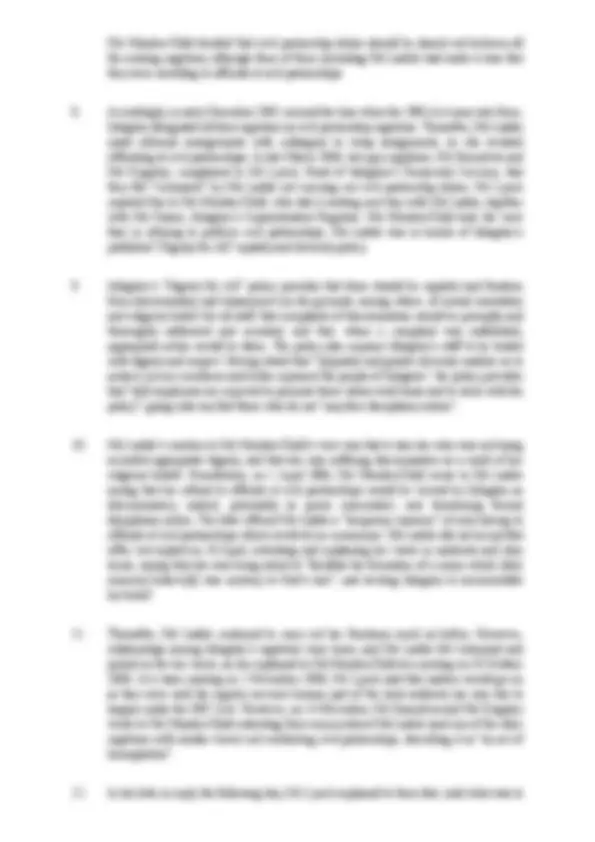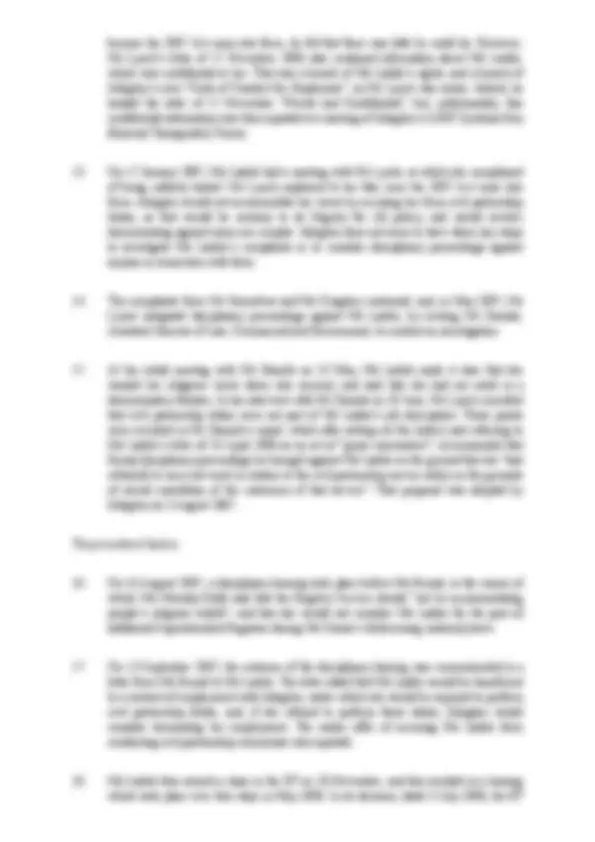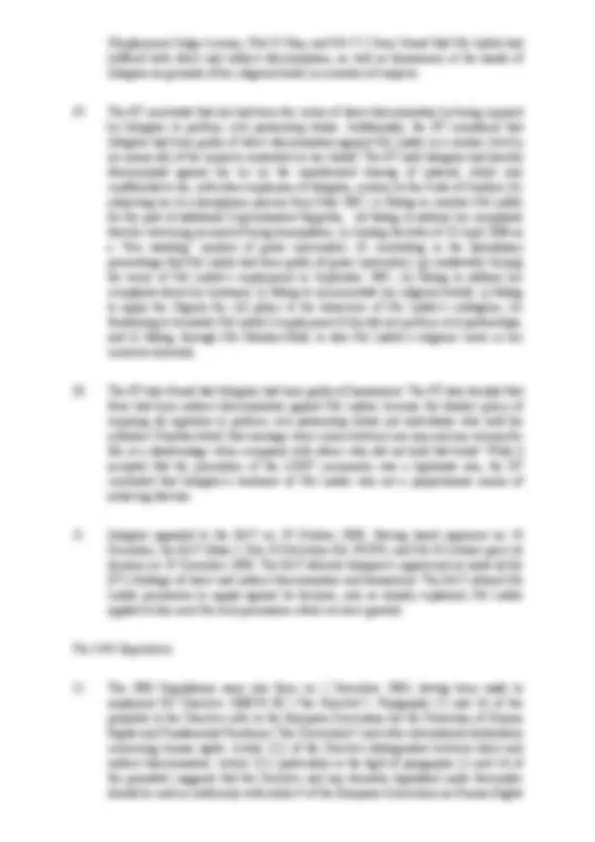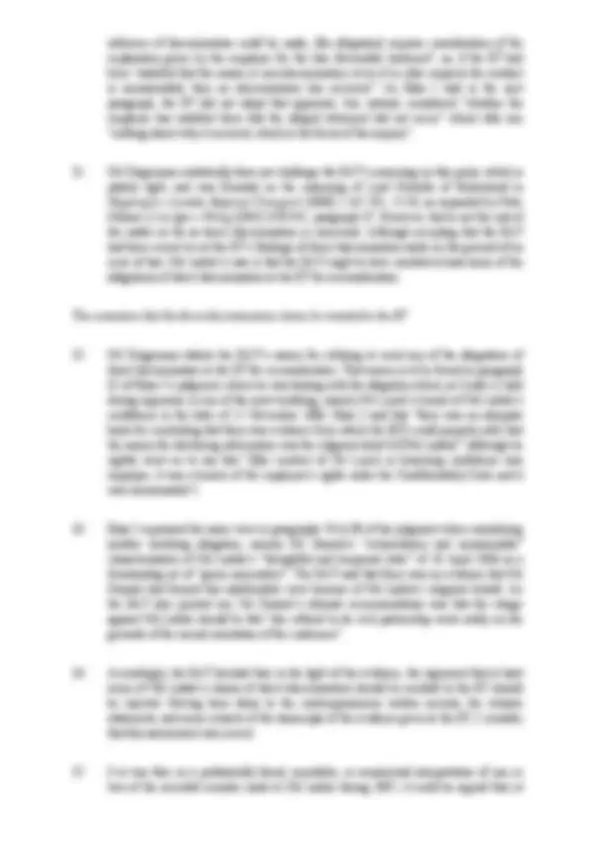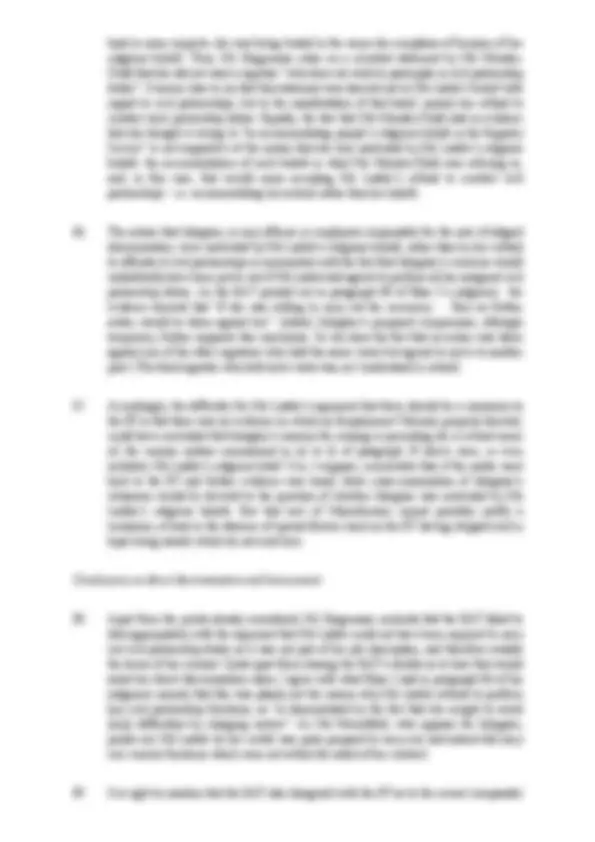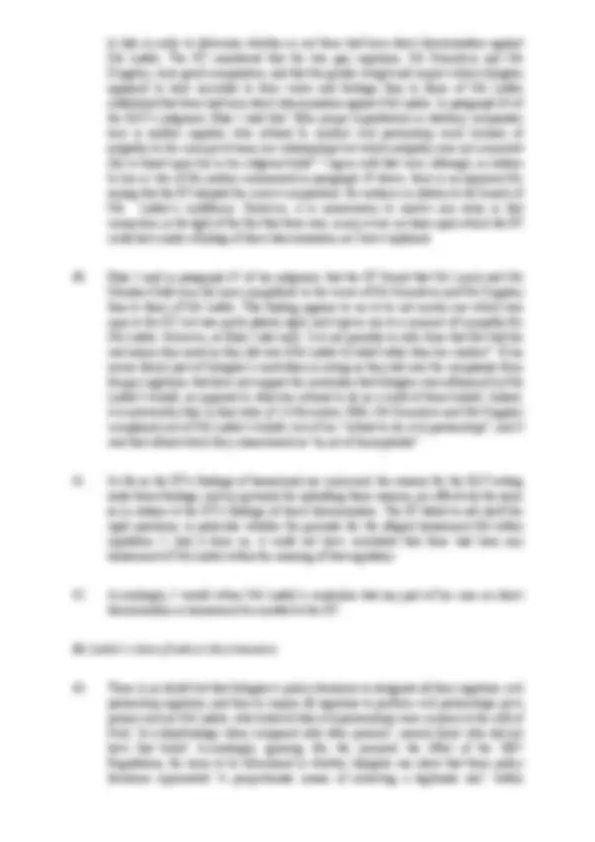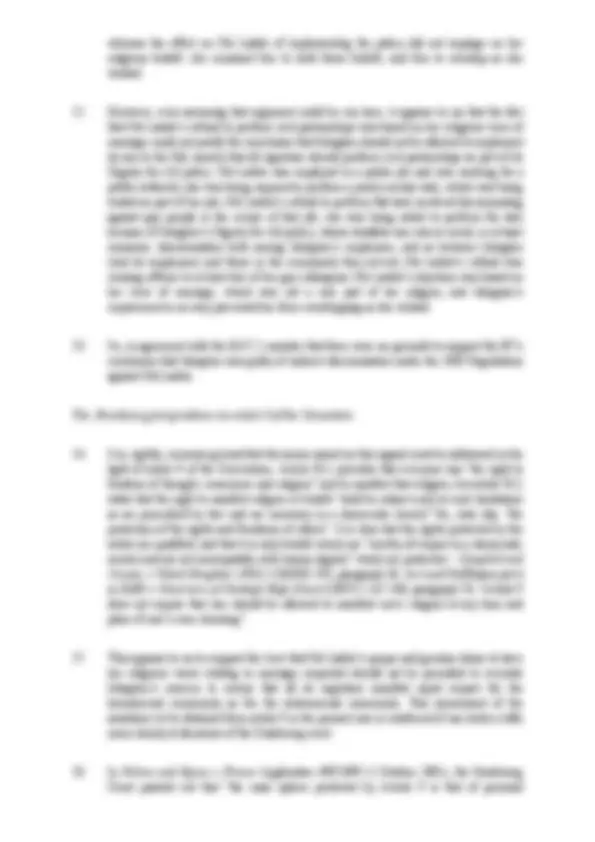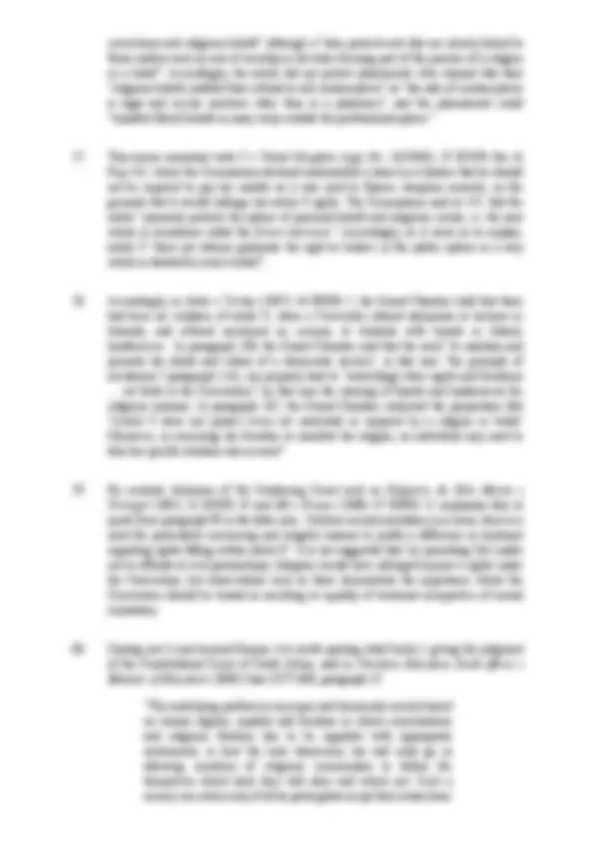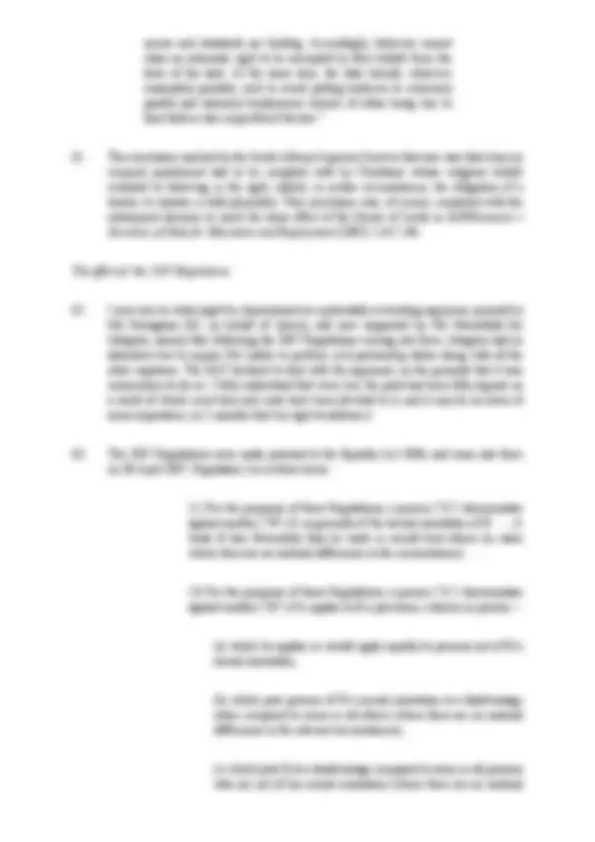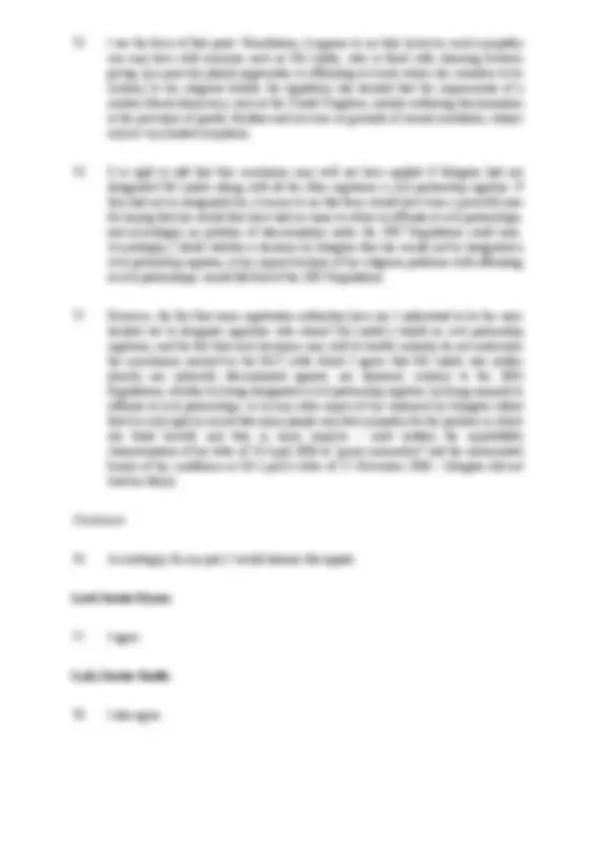Download Ladele vs. Islington: Discrimination Case in London and more Lecture notes Religion in PDF only on Docsity!
Neutral Citation Number: [2009] EWCA Civ 1357 Case No: A2/2009/ COURT OF APPEAL (CIVIL DIVISION) ON APPEAL FROM EMPLOYMENT APPEAL TRIBUNAL The Hon Mr Justice Elias, Mrs M McArthur BA FCIPD, Ms B Switzer Appeal No UKEAT/ 0453 / 08 /RN Royal Courts of Justice Strand, London, WC 2 A 2 LL Date: 15 / 12 / 2009 Before : MASTER OF THE ROLLS LORD JUSTICE DYSON and LADY JUSTICE SMITH
**Between :
LILLIAN LADELE Appellant Claimant
- and - THE LONDON BOROUGH OF ISLINGTON
- and- LIBERTY Respondent Defendant Intervener**
Mr James Dingemans QC and Ms Sarah Crowther (instructed by Ormerods) for Ms Ladele Ms Helen Mountfield (instructed by London Borough of Islington (Legal Services) ) for London Borough of Islington Ms Karon Monaghan QC and Prof Aileen McColgan instructed by, and for, Liberty Hearing dates : 2 & 3 November 2009
Judgment
The Master of the Rolls :
- This is an appeal, which, at its core, raises the question whether the London Borough of Islington (“Islington”) are entitled to compel Ms Lillian Ladele to register civil partnerships even though she objects to officiating at such registrations on the grounds of her religious beliefs. There are other issues, but that is the core issue. The Employment Tribunal (“the ET”) held that Islington could not so compel Ms Ladele, and concluded that Islington had been guilty of direct and indirect discrimination, and harassment, against Ms Ladele contrary to the Employment Equality (Religion or Belief) Regulations 2003 , SI 2003 / 1660 (“the 2003 Regulations”). The Employment Appeal Tribunal (“the EAT”) reversed this
decision, holding that there had been no breach of those regulations, and that Islington had been entitled to act as they did.
- On this appeal, the position is as follows. Ms Ladele seeks to restore the decision of the ET as to indirect discrimination and harassment, and to have remitted to the ET at least some of the issues of direct discrimination. Islington, on the other hand, say that the EAT were correct, but, following the case advanced by Liberty, they go further, at least on the core issue, and contend that they could not lawfully have acted in any other way in the light of the provisions of the Equality Act (Sexual Orientation) Regulations 2007 , SI 2007 / 1263 (“the 2007 Regulations”).
- Before turning to the relevant facts, it is right to mention one procedural matter. Ms Ladele’s application for permission to appeal against the EAT’s decision was initially considered on paper by Mummery LJ, who adjourned it to be heard on the basis that, if permission was granted, the appeal should immediately follow. Having considered the opening submissions of Mr Dingemans QC on behalf of Ms Ladele, we decided that permission to appeal should be granted, and the hearing then continued and concluded as a full appeal. The factual history
- The facts relevant to the core issue on this appeal are within a small compass, but it is necessary to go into the history in a little more detail, in the light of the other issues.
- Having worked for Islington for the previous ten years, Ms Ladele became one of their registrars of Births, Marriages and Deaths on 14 November 2002. As a registrar, she held a statutory office during the pleasure of the Registrar General (under section 6 of the Registration Services Act 1953 ), although she worked for, and was paid by, Islington as the registration authority. Her status changed on 1 December 2007 , when she became a direct employee of Islington pursuant to the Statistics and Registration Act 2007 , and she remained employed by Islington as a registrar until she resigned with effect from 30 September 2009.
- The Civil Partnership Act 2004 came into force on 5 December 2005. As is common knowledge, it introduced civil partnerships between same sex partners. By section 29 ( 1 ), it defined a “civil partnership registrar” as “an individual who is designated by a registration authority as a civil partnership registrar for its area”. Section 29 ( 2 ) required each “registration authority to ensure that there is a sufficient number of civil partnership registrars for its area to carry out the functions of civil partnership registrars”.
- As the ET put it, Ms Ladele held “the orthodox Christian view that marriage is the union of one man and one woman for life”, and she “could not reconcile her faith with taking an active part in enabling same sex unions to be formed”, believing it to be “contrary to God’s instructions”. In anticipation of the 2004 Act coming into force, Ms Ladele told her line- manager, Ms Mendez-Child, that she would not want to officiate at civil partnerships, and reiterated her position to Ms Round, Islington’s Director of Corporate Affairs. Between May and November 2005 , Ms Ladele was absent owing to sickness; during that period,
become the 2007 Act came into force, he felt that there was little he could do. However, Mr Lynch’s letter of 15 November 2006 also contained information about Ms Ladele, which was confidential to her. That was a breach of Ms Ladele’s rights, and a breach of Islington’s own “Code of Conduct for Employees”, as Mr Lynch was aware. Indeed, he headed the letter of 15 November “Private and Confidential”, but, unfortunately, this confidential information was then repeated at a meeting of Islington’s LGBT [Lesbian Gay Bisexual Transgender] Forum.
- On 17 January 2007 , Ms Ladele had a meeting with Mr Lynch, at which she complained of being unfairly treated. Mr Lynch explained to her that, once the 2007 Act came into force, Islington would not accommodate her views by excusing her from civil partnership duties, as that would be contrary to its Dignity for All policy, and would involve discriminating against same sex couples. Islington does not seem to have taken any steps to investigate Ms Ladele’s complaints or to consider disciplinary proceedings against anyone in connection with them.
- The complaints from Mr Goncalves and Ms Kingsley continued, and, in May 2007 , Mr Lynch instigated disciplinary proceedings against Ms Ladele, by inviting Mr Daniels, Assistant Director of Law, Commercial and Environment, to conduct an investigation.
- At her initial meeting with Mr Daniels on 23 May, Ms Ladele made it clear that she wanted her religious views taken into account, and said that she had not acted in a discriminatory fashion. In his interview with Mr Daniels on 20 June, Mr Lynch conceded that civil partnership duties were not part of Ms Ladele’s job description. These points were recorded in Mr Daniels’s report, which after setting out the history and referring to Ms Ladele’s letter of 18 April 2006 as an act of “gross misconduct”, recommended that formal disciplinary proceedings be brought against Ms Ladele on the ground that she “had refus[ed] to carry out work in relation to the civil partnership service solely on the grounds of sexual orientation of the customers of that service”. That proposal was adopted by Islington on 3 August 2007. The procedural history
- On 16 August 2007 , a disciplinary hearing took place before Ms Round, in the course of which Ms Mendez-Child said that the Registry Service should “not be accommodating people’s religious beliefs”, and that she would not consider Ms Ladele for the post of additional Superintendent Registrar during Ms Caines’s forthcoming maternity leave.
- On 13 September 2007 , the outcome of the disciplinary hearing was communicated in a letter from Ms Round to Ms Ladele. The letter stated that Ms Ladele would be transferred to a contract of employment with Islington, under which she would be required to perform civil partnership duties, and, if she refused to perform those duties, Islington would consider terminating her employment. The earlier offer of excusing Ms Ladele from conducting civil partnership ceremonies was repeated.
- Ms Ladele then issued a claim in the ET on 28 November, and this resulted in a hearing which took place over four days in May 2008. In its decision, dated 3 July 2008 , the ET
(Employment Judge Lewzey, Mrs D May, and Mr C J Storr) found that Ms Ladele had suffered both direct and indirect discrimination, as well as harassment, at the hands of Islington on grounds of her religious belief, in a number of respects.
- The ET concluded that she had been the victim of direct discrimination by being required by Islington to perform civil partnership duties. Additionally, the ET considered that Islington had been guilty of direct discrimination against Ms Ladele in a number (but by no means all) of the respects contended on her behalf. The ET held Islington had directly discriminated against her by (a) the unauthorised sharing of material, which was confidential to her, with other employees of Islington, contrary to the Code of Conduct, (b) subjecting her to a disciplinary process from May 2007 , (c) failing to consider Ms Ladele for the post of additional Superintendent Registrar, (d) failing to address her complaints that she was being accused of being homophobic, (e) treating the letter of 18 April 2006 as a “free standing” incident of gross misconduct, (f) concluding in the disciplinary proceedings that Ms Ladele had been guilty of gross misconduct, (g) unilaterally varying the terms of Ms Ladele’s employment in September 2007 , (h) failing to address her complaints about her treatment, (i) failing to accommodate her religious beliefs, (j) failing to apply the Dignity for All policy to the behaviour of Ms Ladele’s colleagues, (k) threatening to terminate Ms Ladele’s employment if she did not perform civil partnerships, and (l) failing, through Ms Mendez-Child, to take Ms Ladele’s religious views or her concerns seriously.
- The ET also found that Islington had been guilty of harassment. The ET also decided that there had been indirect discrimination against Ms Ladele, because the blanket policy of requiring all registrars to perform civil partnership duties put individuals who held the orthodox Christian belief, that marriage was a union between one man and one woman for life, at a disadvantage when compared with others who did not hold that belief. While it accepted that the promotion of the LGBT community was a legitimate aim, the ET concluded that Islington’s treatment of Ms Ladele was not a proportionate means of achieving that aim.
- Islington appealed to the EAT on 29 October 2008. Having heard argument on 10 December, the EAT (Elias J, Mrs M McArthur BA FCIPD, and Ms B Switzer) gave its decision on 19 December 2008. The EAT allowed Islington’s appeal and set aside all the ET’s findings of direct and indirect discrimination and harassment. The EAT refused Ms Ladele permission to appeal against its decision, and, as already explained, Ms Ladele applied to this court for such permission which we have granted. The 2003 Regulations
- The 2003 Regulations came into force on 2 December 2003 , having been made to implement EU Directive 2000 / 78 EC (“the Directive”). Paragraphs ( 1 ) and ( 4 ) of the preamble to the Directive refer to the European Convention for the Protection of Human Rights and Fundamental Freedoms (“the Convention”) and other international declarations concerning human rights. Article 2 ( 2 ) of the Directive distinguishes between direct and indirect discrimination. Article 2 ( 5 ) (particularly in the light of paragraphs ( 1 ) and ( 4 ) of the preamble) suggests that the Directive and any domestic legislation made thereunder should be read in conformity with article 9 of the European Convention on Human Rights
(c) by refusing to afford him, or deliberately not affording him, any such opportunity; or (d) by dismissing him, or subjecting him to any other detriment.” Regulation 6 ( 3 ) makes it unlawful for any employer to subject any of his employees to harassment.
- Regulation 10 ( 1 ) provides that, in relation to “an appointment to an office or a post”, it is unlawful to discriminate against a person (a) in determining to whom the appointment should be offered, (b) when deciding the terms on which the appointment is offered, or (c) by refusing to offer him the appointment. Regulation 10 ( 3 ) renders it unlawful to discriminate against a person who has been so appointed (a) in the terms of appointment, (b) in the opportunities afforded for promotion or transfer, (c) by terminating the appointment, or (d) “by subjecting him to any other detriment in relation to the appointment.” Regulation 10 ( 4 ) outlaws harassment of an office-holder.
- Regulation 22 ( 1 ) states that “[A]nything done by a person in the course of his employment shall be treated for the purpose of these Regulations as done by his employer as well as by him…” However, regulation 22 ( 3 ) provides an employer with a defence if he took “such steps as were reasonably practicable to prevent the employee from doing [the act in question]”. Regulation 23 renders a person who “knowingly aids” another person to do an act which infringes the Regulations liable for that act.
- The Employment Equality (Sexual Orientation) Regulations 2003 , SI 2003 / 1661 (“the 2003 Sexual Orientation Regulations”), which came into force on 1 December 2003 , were also made pursuant to the Directive. Those regulations prohibit discrimination in the fields of employment and office-holding on grounds of sexual orientation in very similar terms to those contained in the 2003 Regulations in relation to religion and belief. The ET’s finding on direct discrimination
- The ET’s conclusion that Ms Ladele suffered direct discrimination on the core issue, namely, by being required by Islington to conduct civil partnerships, is as the EAT said, in paragraph 52 of Elias J’s impressive and cogent judgment, “quite unsustainable”. As he went on to explain, Ms Ladele’s complaint “is not that she was treated differently from others; rather it was that she was not treated differently when she ought to have been”, and her complaint was “about a failure to accommodate her difference, rather than a complaint that she is being discriminated against because of that difference”. As Elias J said in the next paragraph of his judgment, “[i]t cannot constitute direct discrimination to treat all employees in precisely the same way.” This error also applied to virtually all of the other findings of direct discrimination by the ET, as summarised in paragraph 19 above.
- A similar error of law in the ET’s approach, which applies to virtually every allegation of direct discrimination, was identified by the EAT, and was expressed by Elias J in paragraph 59 in these terms: “Even if … there is sufficient evidence from which an
inference of discrimination could be made, [the allegation] requires consideration of the explanation given by the employer for the less favourable treatment”, as, if the ET had been “satisfied that the reason is non-discriminatory (even if in other respects the conduct is unreasonable) then no discrimination has occurred.” As Elias J said in the next paragraph, the ET did not adopt that approach, but, instead, considered “whether the employer has satisfied them that the alleged detriment did not occur” which tells one “nothing about why it occurred, which is the focus of the enquiry”.
- Mr Dingemans realistically does not challenge the EAT’s reasoning on this point, which is plainly right, and was founded on the reasoning of Lord Nicholls of Birkenhead in Nagarajan v London Regional Transport [ 2000 ] 1 AC 501 , 511 H, as expanded by Peter Gibson LJ in Igen v Wong [ 2005 ] ICR 931 , paragraph 37. However, that is not the end of the matter so far as direct discrimination is concerned. Although accepting that the EAT had been correct to set the ET’s findings of direct discrimination aside on the ground of an error of law, Ms Ladele’s case is that the EAT ought to have remitted at least some of the allegations of direct discrimination to the ET for reconsideration. The contention that the direct discrimination claims be remitted to the ET
- Mr Dingemans attacks the EAT’s reason for refusing to remit any of the allegations of direct discrimination to the ET for reconsideration. That reason is to be found in paragraph 62 of Elias J’s judgment, where he was dealing with the allegation which, as Smith LJ said during argument, is one of the most troubling, namely Mr Lynch’s breach of Ms Ladele’s confidence in the letter of 15 November 2006. Elias J said that “there was no adequate basis for concluding that there was evidence from which the [ET] could properly infer that the reason for disclosing information was the religious belief of [Ms Ladele]” (although he rightly went on to say that “[t]he conduct of Mr Lynch in breaching confidence was improper; it was a breach of the employee’s rights under the Confidentiality Code and it was unreasonable”).
- Elias J expressed the same view in paragraphs 76 to 80 of his judgment when considering another troubling allegation, namely Mr Daniels’s “extraordinary and unreasonable” characterisation of Ms Ladele’s “thoughtful and temperate letter” of 18 April 2006 as a freestanding act of “gross misconduct”. The EAT said that there was no evidence that Mr Daniels had formed this indefensible view because of Ms Ladele’s religious beliefs. As the EAT also pointed out, Mr Daniels’s ultimate recommendation was that the charge against Ms Ladele should be that “she refused to do civil partnership work solely on the grounds of the sexual orientation of the customers”.
- Accordingly, the EAT decided that, in the light of the evidence, the argument that at least some of Ms Ladele’s claims of direct discrimination should be remitted to the ET should be rejected. Having been taken to the contemporaneous written records, the witness statements, and some extracts of the transcripts of the evidence given to the ET, I consider that this assessment was correct.
- It is true that, on a pedantically literal, unrealistic, or acontextual interpretation of one or two of the recorded remarks made to Ms Ladele during 2007 , it could be argued that, at
to take in order to determine whether or not there had been direct discrimination against Ms Ladele. The ET considered that the two gay registrars, Mr Goncalves and Ms Kingsley, were good comparators, and that the greater weight and respect which Islington appeared to have accorded to their views and feelings than to those of Ms Ladele established that there had been direct discrimination against Ms Ladele. In paragraph 64 of the EAT’s judgment, Elias J said that “[t]he proper hypothetical or statutory comparator here is another registrar who refused to conduct civil partnership work because of antipathy to the concept of same sex relationships but which antipathy was not connected [to] or based upon his or her religious belief”. I agree with that view, although, in relation to one or two of the matters summarised in paragraph 19 above, there is an argument for saying that the ET adopted the correct comparators: for instance in relation to the breach of Ms Ladele’s confidence. However, it is unnecessary to resolve any issue in that connection, in the light of the fact that there was, in any event, no basis upon which the ET could have made a finding of direct discrimination, as I have explained.
- Elias J said in paragraph 67 of his judgment, that the ET found that Mr Lynch and Ms Mendez-Child were far more sympathetic to the views of Mr Goncalves and Ms Kingsley than to those of Ms Ladele. This finding appears to me to be not merely one which was open to the ET, but was pretty plainly right, and it gives rise to a measure of sympathy for Ms Ladele. However, as Elias J also said, “it is not possible to infer from that fact that the real reason they acted as they did was [Ms Ladele’s] belief rather than her conduct”. If (as seems likely) part of Islington’s motivation in acting as they did was the complaints from the gay registrars, that does not support the contention that Islington was influenced by Ms Ladele’s beliefs, as opposed to what she refused to do as a result of those beliefs. Indeed, it is noteworthy that, in their letter of 14 November 2006 , Mr Goncalves and Ms Kingsley complained not of Ms Ladele’s beliefs, but of her “refusal to do civil partnerships”, and it was that refusal which they characterised as “an act of homophobia”.
- So far as the ET’s findings of harassment are concerned, the reasons for the EAT setting aside those findings, and my grounds for upholding those reasons, are effectively the same as in relation to the ET’s findings of direct discrimination. The ET failed to ask itself the right questions, in particular whether the grounds for the alleged harassment fell within regulation 5 ; had it done so, it could not have concluded that there had been any harassment of Ms Ladele within the meaning of that regulation.
- Accordingly, I would refuse Ms Ladele’s contention that any part of her case on direct discrimination or harassment be remitted to the ET. Ms Ladele’s claim of indirect discrimination
- There is no doubt but that Islington’s policy decisions to designate all their registrars civil partnership registrars, and then to require all registrars to perform civil partnerships put a person such as Ms Ladele, who believed that civil partnerships were contrary to the will of God, “at a disadvantage when compared with other persons”, namely those who did not have that belief. Accordingly, ignoring (for the moment) the effect of the 2007 Regulations, the issue to be determined is whether Islington can show that these policy decisions represented “a proportionate means of achieving a legitimate aim” within
regulation 3 ( 1 ) of the 2003 Regulations.
- The first argument raised on behalf of Ms Ladele is that the ET correctly identified the aim by reference to which Islington sought to justify their treatment of Ms Ladele as being “to provide effective civil partnership arrangements”, and that the ET was, to put it at its lowest, entitled to conclude that, while this was a legitimate aim, the treatment of Ms Ladele was not, in all the circumstances, a proportionate means of achieving the aim. If one starts with Ms Ladele’s wish not to officiate at civil partnerships, and assumes that Islington’s justification for not accommodating that wish was simply their desire to have an effective system for registering civil partnerships, then it is easy to see the force of this argument. Particularly as the other two registrars who shared Ms Ladele’s views and wishes were no longer registrars by autumn 2006 , it is pretty clear that, by accommodating the wishes of the only registrar who wanted to avoid civil partnership functions, Islington would not have significantly, if at all, impaired the quality of their registry services, whether in the field of civil partnerships or otherwise.
- The problem with the ET’s analysis is, as the EAT pointed out, that it wrongly identifies Islington’s aim, as it overlooks the point that the service which Islington stated that they aimed to provide was not merely one which was effective in terms of practicality and efficiency, but was also one which complied with their overarching policy of being “an employer and a public authority wholly committed to the promotion of equal opportunities and to requiring all its employees to act in a way which does not discriminate against others”, to quote from Ms Mountfield’s argument on behalf of Islington (and which very closely reflects Islington’s written case in the ET). Mr Dingemans’ response, namely that it was not open to the EAT to interfere with the ET’s identification of Islington’s aim, on the ground that it was a finding of fact, is, in my view, wrong. In paragraphs 86 and 87 of its decision, the ET does not appear to have rejected Islington’s case as to their aim; what the ET did in those paragraphs was to mischaracterise Islington’s aim by treating it as a purely practical one of delivering an efficient system. In any event, there would have been no basis for rejecting Islington’s characterisation of their aim: it was supported by the Dignity for All policy, and the evidence, both in contemporaneous documentary form and orally before the ET, relating to Ms Ladele’s complaints.
- Islington wished to ensure that all their registrars were designated to conduct, and did conduct, civil partnerships as they regarded this as consistent with their strong commitment to fighting discrimination, both externally, for the benefit of the residents of the borough, and internally in the sense of relations with and between their employees. I find it very hard to see how this could be challenged, either as being Islington’s actual aim, in the light of the evidence, or as being a legitimate aim, in the light of Islington’s Dignity for All policy, current legislation and mainstream thinking.
- If, contrary to his submissions, the EAT was (as I think) right in its identification of the actual aim of Islington and in holding that that aim was legitimate, then Mr Dingemans contends that the EAT was nonetheless wrong to overturn the ET’s conclusion that Islington’s requirement that Ms Ladele perform civil partnership functions, when she did not wish to do so for bona fide religious reasons, was a disproportionate means of achieving that aim. He relies on Pill LJ’s statement in Hardy & Hansons plc v Lax [ 2005 ] ICR 1565 , paragraph 31 , that it is for “the tribunal … to make its own judgment, upon a
whereas the effect on Ms Ladele of implementing the policy did not impinge on her religious beliefs: she remained free to hold those beliefs, and free to worship as she wished.
- However, even assuming that argument could be run here, it appears to me that the fact that Ms Ladele’s refusal to perform civil partnerships was based on her religious view of marriage could not justify the conclusion that Islington should not be allowed to implement its aim to the full, namely that all registrars should perform civil partnerships as part of its Dignity for All policy. Ms Ladele was employed in a public job and was working for a public authority; she was being required to perform a purely secular task, which was being treated as part of her job; Ms Ladele’s refusal to perform that task involved discriminating against gay people in the course of that job; she was being asked to perform the task because of Islington’s Dignity for All policy, whose laudable aim was to avoid, or at least minimise, discrimination both among Islington’s employees, and as between Islington (and its employees) and those in the community they served; Ms Ladele’s refusal was causing offence to at least two of her gay colleagues; Ms Ladele’s objection was based on her view of marriage, which was not a core part of her religion; and Islington’s requirement in no way prevented her from worshipping as she wished.
- So, in agreement with the EAT, I consider that there were no grounds to support the ET’s conclusion that Islington was guilty of indirect discrimination under the 2003 Regulations against Ms Ladele. The Strasbourg jurisprudence on article 9 of the Convention
- It is, rightly, common ground that the issues raised on this appeal must be addressed in the light of article 9 of the Convention. Article 9 ( 1 ) provides that everyone has “the right to freedom of thought, conscience and religion” and to manifest that religion, but article 9 ( 2 ) states that the right to manifest religion or beliefs “shall be subject only to such limitations as are prescribed by law and are necessary in a democratic society” for, inter alia, “the protection of the rights and freedoms of others”. It is clear that the rights protected by the article are qualified, and that it is only beliefs which are “worthy of respect in a democratic society and are not incompatible with human dignity” which are protected – Campbell and Cosans v United Kingdom ( 1982 ) 4 EHRR 293 , paragraph 36. As Lord Hoffmann put it in R(SB) v Governors of Denbigh High School [ 2007 ] 1 AC 100 , paragraph 50 , “Article 9 does not require that one should be allowed to manifest one’s religion at any time and place of one’s own choosing”.
- This appears to me to support the view that Ms Ladele’s proper and genuine desire to have her religious views relating to marriage respected should not be permitted to override Islington’s concern to ensure that all its registrars manifest equal respect for the homosexual community as for the heterosexual community. This assessment of the assistance to be obtained from article 9 in the present case is reinforced if one looks a little more closely at decisions of the Strasbourg court.
- In Pichon and Sajous v France Application 49853 / 99 ( 2 October 2001 ), the Strasbourg Court pointed out that “the main sphere protected by Article 9 is that of personal
convictions and religious beliefs” although it “also protects acts that are closely linked to those matters such as acts of worship or devotion forming part of the practice of a religion or a belief”. Accordingly, the article did not protect pharmacists who claimed that their “religious beliefs justified their refusal to sell contraceptives” as “the sale of contraceptives is legal and occurs nowhere other than in a pharmacy”, and the pharmacists could “manifest [their] beliefs in many ways outside the professional sphere.”
- This seems consistent with C v United Kingdom App. No. 10358 / 83 , 37 ECHR Dec & Rep 142 , where the Commission declared inadmissible a claim by a Quaker that he should not be required to pay tax insofar as it was used to finance weapons research, on the grounds that it would infringe his article 9 rights. The Commission said at 147 , that the article “primarily protects the sphere of personal beliefs and religious creeds, i.e. the area which is sometimes called the forum internum .” Accordingly, as it went on to explain, article 9 “does not always guarantee the right to behave in the public sphere in a way which is dictated by such a belief”.
- Accordingly, in Sahin v Turkey ( 2007 ) 44 EHRR 5 , the Grand Chamber held that there had been no violation of article 9 , when a University refused admission to lectures or tutorials, and refused enrolment on courses, to students with beards or Islamic headscarves. In paragraph 108 , the Grand Chamber said that the need “to maintain and promote the ideals and values of a democratic society”, in that case “the principle of secularism” (paragraph 116 ), can properly lead to “restrict[ing] other rights and freedoms … set forth in the Convention” (in that case the wearing of beards and headscarves for religious reasons). In paragraph 105 , the Grand Chamber endorsed the proposition that “Article 9 does not protect every act motivated or inspired by a religion or belief. Moreover, in exercising his freedom to manifest his religion, an individual may need to take his specific situation into account”.
- By contrast, decisions of the Strasbourg Court such as Salguerio da Silva Mouta v Portugal ( 2001 ) 31 EHRR 47 and EB v France ( 2008 ) 47 EHRR 21 emphasise that, to quote from paragraph 90 in the latter case, “[w]here sexual orientation is in issue, there is a need for particularly convincing and weighty reasons to justify a difference in treatment regarding rights falling within article 8 ”. It is not suggested that, by permitting Ms Ladele not to officiate at civil partnerships, Islington would have infringed anyone’s rights under the Convention, but observations such as these demonstrate the importance which the Convention should be treated as ascribing to equality of treatment irrespective of sexual orientation.
- Casting one’s eyes beyond Europe, it is worth quoting what Sachs J, giving the judgment of the Constitutional Court of South Africa, said in Christian Education South Africa v Minister of Education ( 2000 ) Case CCT 4 / 00 , paragraph 35 : “The underlying problem in any open and democratic society based on human dignity, equality and freedom in which conscientious and religious freedom has to be regarded with appropriate seriousness, is how far such democracy can and must go in allowing members of religious communities to define for themselves which laws they will obey and which not. Such a society can cohere only if all its participants accept that certain basic
differences in the relevant circumstances), and (d) which A cannot reasonably justify by reference to matters other than B’s sexual orientation.” Thus, there are, in slightly different words, the familiar provisions for direct and indirect discrimination. Regulation 3 ( 4 ) states that civil partnership is not materially different from marriage for these purposes.
- Regulation 4 ( 1 ) provides: “It is unlawful for a person (“A”) concerned with the provision to the public or a section of the public of goods, facilities or services to discriminate …. – (a) by refusing to provide B with goods, facilities or services…..” Regulation 4 ( 3 ) provides that Regulation 4 ( 1 ) “does not apply … in relation to the provision of … services by a person exercising a public function”, but this must be read in the light of regulation 8.
- Regulation 8 ( 1 ) states that it is “unlawful for a public authority exercising a function to do any act which constitutes discrimination”; “public authority” is defined in regulation 8 ( 2 ) as including “any person who has functions of a public nature…”. Regulation 9 ( 1 ) renders it unlawful for any person “to operate a practice which would be likely to result in unlawful discrimination …”. Regulation 11 ( 1 ) renders it unlawful for a person to instruct or cause, or attempt to cause, another to discriminate unlawfully.
- Regulations 29 and 30 contain provisions relating to aiding and employers’ liability for employees’ acts which are similar (but not identical) to regulations 22 and 23 respectively of the 2003 Regulations.
- Regulation 14 contains certain limited exceptions in relation to “organisations the purpose of which is” the practice, advancement, or the like, of “a religion or belief”. In particular, by paragraphs ( 3 ) and ( 5 ), it states that the regulations which I have referred to do not apply to restrictions on the membership, on the activities undertaken by, or on the provision of goods facilities and services under the auspices of, such organisations, provided that the restrictions are necessary to comply with the organisation’s doctrine, or to avoid conflict with the “strongly held religious convictions of a significant number of the religion’s followers”.
- Liberty’s argument is simple, and is based purely on the natural meaning of the 2007 Regulations, and it has three stages. The first stage is an assertion that a refusal to perform civil partnerships, on the part of someone who is quite prepared to perform marriages, amounts to discrimination as defined in Regulation 3 ( 1 ) and ( 3 ), as the requirements of
paragraphs ( 3 )(a) to (d) are satisfied, and it cannot be said, in the light of Regulation 3 ( 4 ), that marriage and civil partnership are “materially different”. The second stage involves the contention that officiating at marriages and civil partnerships involves “the provision to the public or a section of the public of … services” within paragraph 4 ( 1 ), and, if that is not applicable in the light of regulation 4 ( 3 ), then regulation 8 ( 1 ) and ( 2 ) apply, as Islington and Ms Ladele are both “public authorit[ies]” “exercising a function”. Further, if not otherwise liable for Ms Ladele’s refusal to conduct civil partnerships, regulation 30 would seem to render Islington liable for any unlawfulness.
- I find it hard to see any logical flaw in those two stages of the argument, at least once Ms Ladele had been designated a civil partnership registrar. The third, and final, stage in Liberty’s argument is that, even if Ms Ladele had succeeded in establishing that Islington would not otherwise have been entitled to require her to perform civil partnerships, the effect of this analysis of the impact of the 2007 Regulations means that, at least once Ms Ladele was designated a civil partnership registrar, Islington were not merely entitled, but obliged, to require her to do so. This argument effectively involves saying that the prohibition of discrimination by the 2007 Regulations takes precedence over any right which a person would otherwise have by virtue of his or her religious belief or faith, to practice discrimination on the ground of sexual orientation.
- Such an argument, in my view, accords with the natural meaning of the 2007 Regulations, and is supported by the provisions of Regulation 14 , which identifies the relatively limited circumstances in which it is permissible to discriminate against anyone on grounds of sexual orientation because of one’s religious belief: those circumstances are essentially limited to the membership and operation of “organisations relating to religion or belief”, which plainly does not cover performing civil partnership unions, which is self-evidently a secular activity carried out in a public sphere under the auspices of a public, secular body.
- Once it is decided that there is nothing in the 2003 Regulations which entitles Ms Ladele, having been designated a civil partnership registrar, to insist on her right not to have civil partnership duties assigned to her because of her religious beliefs in relation to marriage, it means that there is no inconsistency, so far as other legislation is concerned, in giving the subsequent 2007 Regulations their natural meaning, namely that it is simply unlawful for Ms Ladele to refuse to perform civil partnerships. It is also hard to resist the conclusion that this means that Islington had no alternative but to insist on her performing such duties together with their other registrars.
- It would also appear to follow that it would be difficult for Islington, having designated her a civil partnership registrar, to justify the offer they made Ms Ladele, namely that she officiate only at civil partnerships which involve no ceremonies. The EAT said in paragraph 15 of Elias J’s judgment that they “would be sorry if pragmatic ways of seeking to accommodate beliefs were impermissible” so that “choosing not to designate those with strong religious objections [as civil partnership registrars, as some local authorities do] would be a lawful way of reconciling conflicts in this highly sensitive area”. As Elias J went on to say, “[f]undamental changes in social attitudes, particularly with regard to sexual orientation, are happening very fast and for some – and not only those with religious objections – they are genuinely perplexing. In that context, there seems … to be some virtue in taking a pragmatic line if it is lawful.”

